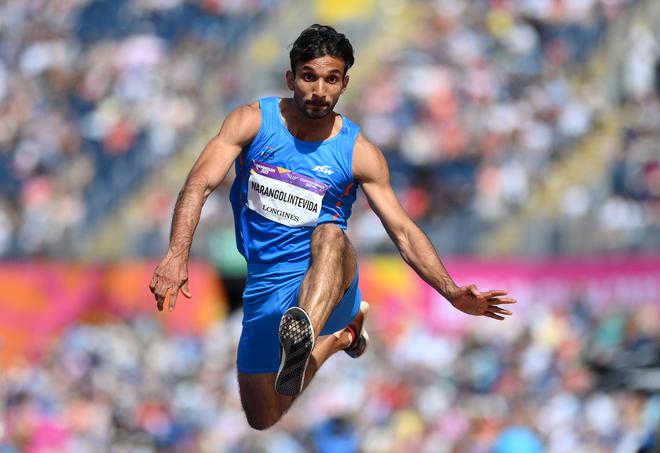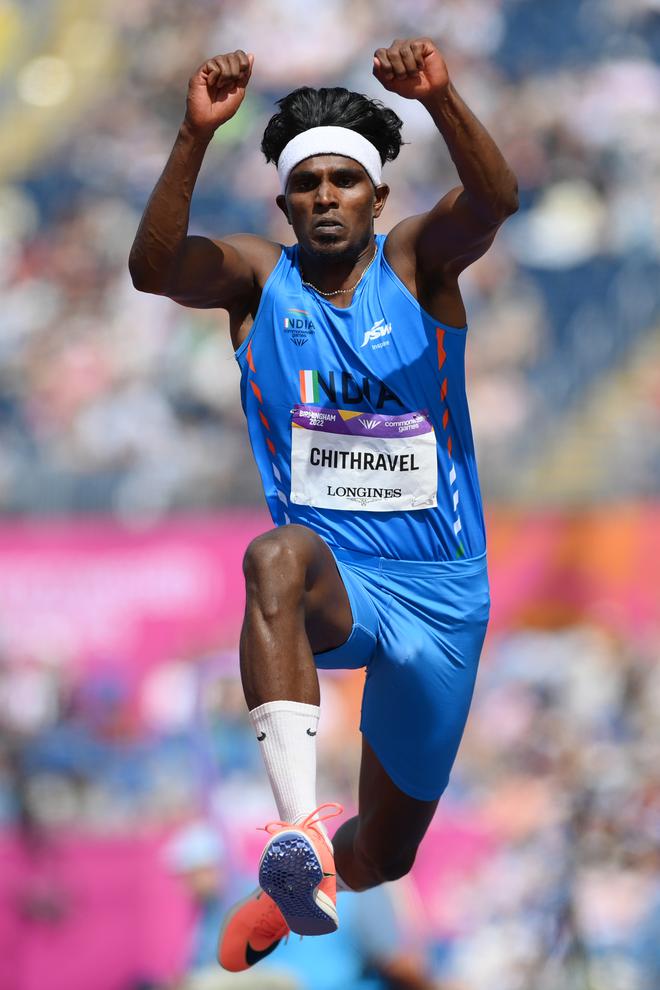

Eldhose Paul used to be a decent cricketer. A fast-bowler, he played college-level tournaments.
“Whenever I got time after my athletics workouts, I used to play cricket for my college team, I’ve played for MA College [at Kothamangalam, Ernakulam] in MG University events too,” says the 25-year-old.
“But there was nobody to guide me about how to go about cricket, to do proper workouts. And cricket is an expensive sport.”
Perhaps it is for the best that Paul did not get swept away by the cricket wave. For the young man has made history in another sport, the triple jump.
Paul finished ninth at the World Athletics Championships in Oregon (USA) in late July and last month became the first Indian triple jumper to win the Commonwealth Games gold, in Birmingham. The joy was doubled, with his very consistent training-mate Abdulla Aboobacker taking silver. Praveen Chithravel missed the bronze by four centimetres.
A rare thing
The 17m in triple jump used to be a rare thing in Indian athletics. Olympian Renjith Maheswary first entered the elite circle with 17.04m in June 2007 in Guwahati. And before this year, Asian Games gold medallist Arpinder Singh was the last to cross 17m with 17.09 in 2018.
And when former Asian champion Maheswary jumped 17.30m in 2016 (he was fourth in the world list that year) for a new National record in Bengaluru, a month before the Rio Olympics, many rubbed their eyes in disbelief.
But 2022 has raised triple jump in India as never before. In a two-month period, May and June, three jumpers — Kerala’s Aboobacker (17.19m) and Karthik Unnikrishnan (17.10) and Tamil Nadu’s Chithravel (17.18) — breached 17m and grabbed three of the top five rungs in the Indian all-time jumpers’ list. And Paul is on the edge of the landmark, in sixth spot with 16.99m.
How did this happen?
“Mainly, it’s teamwork. Three of us [Paul, Aboobacker and Unnikrishnan] do our workouts together. All of us are in the same performance range, so there is a strong competitive spirit,” says Paul, who despite not having officially crossed 17m (the 17.03 that fetched him the Commonwealth Games gold was wind-aided, +3.1 wind), covered himself in glory this year.
“We are almost like brothers, we support each other well and even help out during competitions. So, every day there is some improvement. If we had been training in different places, perhaps India would not have got such performances from us. And we train under the same coach M. Harikrishnan [at the national camp in Bengaluru; former two-time Worlds silver medallist Yoandri Betanzos of Cuba coaches Chithravel at JSW’s Inspire Institute of Sport, Ballari].”
Why have the triple jumpers responded so well to Harikrishnan’s methods?
“One, my workouts are suitable for their body, next… their faith in the coach, they blindly believe in me. And third is hard work,” says Harikrishnan, who was not sent for the World Championships but coached them online around midnight every day from the national camp.
“I’m very lucky to have students like them. And I have another youngster, Gailey Venister from Tamil Nadu, who is also very promising.”
Like 2021, which had the Tokyo Olympics, and this year (Worlds and CWG), 2023 too will be very busy, with the Worlds again in Budapest (August), the Asian Games in Hangzhou (Sept-Oct) and the Asian Championships (most probably in Pattaya, July).
With so many majors lined up, Paul feels Maheswary’s National record of 17.30m will fall.
Under threat
“I’m sure one of us will break the National record and the best jump next year could be around 17.40m. The World Championships entry standard (17.20m) is an achievable target. The last two major competitions have given me a big boost for next season. More than happiness, the confidence that big medals bring matter more,” says Paul, who was raised by his grandmother in Ramamangalam, a village near Piravom in Ernakulam District, from the age of four after his mother’s death.
Harikrishnan feels all three are capable of achieving 17.40m next year. “But there should be no injuries,” says the assistant national coach, who like Aboobacker — this year’s India No. 1 — is with the Indian Air Force.
“For Eldhose, it will all depend on the technical corrections I’m working on. There was a problem with his running style, he had a throwing-type running style, we changed that. With that, his hop, rebound and ‘plant’ became set. I will know how much each one can improve once the major corrections are done.”
Paul — earlier coached by T.P. Ouseph, who guided former Worlds long jump bronze medallist Anju Bobby George in her early years — is a quick learner.
“He is quick at grasping things. And Abdulla gets nervous fast but if you motivate him, he will get ready quickly. Physically and mentally, each one is a different make. Karthik has just a motivation problem but he is very mature,” says Harikrishnan.
“Karthik can do a lot better, he should have crossed 17.10 much earlier. In my plan, he should be jumping 17.35 to 17.40 in 2023. And in 2024, around 17.55 to 17.60.”
And Harikrishnan explains the trick that helped Aboobacker grab the silver in Birmingham.
“I could not go for the Commonwealth Games and when I saw that Abdulla was fourth after four jumps, I realised he was in a sort of silent mode. I knew I had to get him worked up to produce a good jump.
“I told [long jumper Muhammed] Anees to carry his mobile and put it on loudspeaker mode so that he could hear it. I told Abdulla, ‘Abdu consider you are a mad man…jump like a mad man, think you are a vattan, a pranthan (mad man). Don’t think about your technique. And have the entire stadium in your grip. Clap and only when you feel motivated, do the jump.’ And he did it!” says the coach.
Unease
Despite the historic Birmingham performance, there is a sense of unease among the triple jumpers. Six months ago, the Athletics Federation of India brought in Russian Denis Kapustin, the 2000 Sydney Olympics bronze medallist, as the head coach for horizontal jumps. The jumpers are worried about the transition when the camp resumes for next year.
“Both Kapustin and Harikrishnan should decide the workouts together, if there is a sudden change our body will take some time to adapt. Gradually, both their workouts should merge…I think that will be the plan going forward,” says Paul.
The possible logistical issues for Kapustin, after Russia’s invasion of Ukraine, are also something that must be considered. The triple jumpers were without a coach at the Worlds and CWG as Kapustin could not get visas and there is a feeling it could trouble them next year too.
Paul feels that competing in Europe next year will give the triple jumpers a big boost.
“The climate there is different, we should get used to it...instead of doing competitions here, we should be competing in European meets and try to peak for the majors through those competitions,” he says.
“We should also try to qualify for the Worlds from foreign competitions and if you are looking to gain ranking points, the Indian meets offer us very few points. The more we compete abroad, the better it will be in major meets.
“In India, we are forced to peak in domestic competition and when we travel abroad, we go down.”
Like the long jumpers, the triple jumpers have offered Indian athletics new hope. It is time to offer them more support and see what they are capable of doing.







